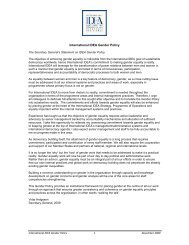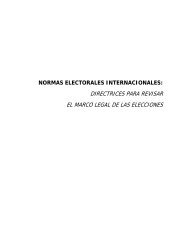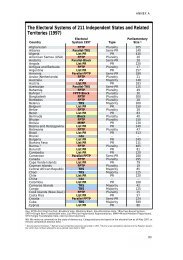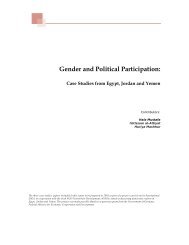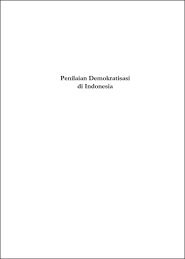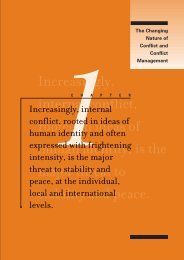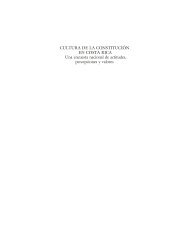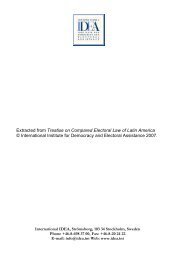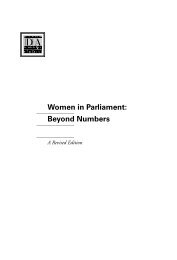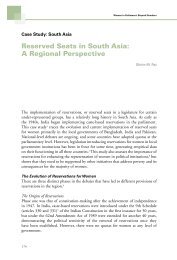The Role of State Constitutions in Protecting ... - International IDEA
The Role of State Constitutions in Protecting ... - International IDEA
The Role of State Constitutions in Protecting ... - International IDEA
Create successful ePaper yourself
Turn your PDF publications into a flip-book with our unique Google optimized e-Paper software.
BURMA: STATE CONSTITUTIONS<br />
AND THE CHALLENGES<br />
FACING THE ETHNIC NATIONALITIES<br />
Chao Tzang Yawnghwe<br />
Introduction: <strong>The</strong> Politics <strong>of</strong> Ethnicity<br />
<strong>The</strong> impression persists that Burma is a country torn by ethnic conflict and<br />
violence, and therefore there is a great danger <strong>of</strong> the country break<strong>in</strong>g up <strong>in</strong>to<br />
fragments like the former Yugoslavia, or fac<strong>in</strong>g <strong>in</strong>ter-ethnic strife and bloodshed<br />
as <strong>in</strong> Bosnia.<br />
This was the justification put forward by the military when it seized power <strong>in</strong><br />
1962 and has been the rationale for military rule ever s<strong>in</strong>ce then. <strong>The</strong> military<br />
claimed that they had to take over power because there was a secession plot by the<br />
leaders <strong>of</strong> the ethnic nationalities (or the “national races”, the term used by the<br />
present regime) 1 . <strong>The</strong>y further claim that without a strong military presence,<br />
there will be secession and <strong>in</strong>ter ethnic violence. This is the justification for<br />
military rule <strong>in</strong> perpetuity.<br />
<strong>The</strong> leadership <strong>of</strong> the ethnic nationalities and resistance movements has focused<br />
on ethnicity. <strong>The</strong>y articulate the aspirations <strong>of</strong> their respective groups for rights<br />
and equality <strong>in</strong> terms <strong>of</strong> ethnicity. For example, they speak <strong>of</strong> a need to secure a<br />
“genu<strong>in</strong>e federal union <strong>of</strong> equal ethnic nations (or nationalities). <strong>The</strong> aspiration<br />
<strong>of</strong> the ethnic groups is not to be dom<strong>in</strong>ated by and imposed upon by another or<br />
other ethnic groups, and to have the right to promote and protect their culture<br />
and environment, <strong>in</strong>clud<strong>in</strong>g land 2 .<br />
<strong>The</strong> aspirations <strong>of</strong> Burma’s ethnic nationalities 3 are no different to that <strong>of</strong> ethnic<br />
groups and m<strong>in</strong>orities (and <strong>in</strong>digenous peoples) elsewhere, who feel endangered,<br />
marg<strong>in</strong>alized and discrim<strong>in</strong>ated aga<strong>in</strong>st by the state. However, <strong>in</strong> another sense,<br />
the Burma context differs from other countries. <strong>The</strong> Union <strong>of</strong> Burma was formed<br />
by an accord signed at Panglong <strong>in</strong> 1947, one year prior to the emergence <strong>of</strong><br />
Burma as an <strong>in</strong>dependent, post-colonial state (<strong>in</strong> 1948). <strong>The</strong> accord was between<br />
the leaders who represented the different territorial entities <strong>of</strong> what became the<br />
Union <strong>of</strong> Burma. In this sense, both historically and conceptually, the ethnic<br />
1) <strong>The</strong> term used here is “ethnic nationalities” rather than “national m<strong>in</strong>orities” to denote the ethnic groups <strong>of</strong> the country.<br />
Burma is a multi-ethnic country. <strong>The</strong> major groups are the Burman, Shan, Karen, Kach<strong>in</strong>, Ch<strong>in</strong>, Rakh<strong>in</strong>e, Mon, and Karenni.<br />
<strong>The</strong>re is <strong>in</strong>deed much confusion as regard the majority-m<strong>in</strong>ority equation. <strong>The</strong>re exists a perception that the Burmans are<br />
the majority, <strong>in</strong> the absolute sense, and that the rest are ethnic m<strong>in</strong>orities. While the Burmans do <strong>in</strong>deed constitute an<br />
overall majority (perhaps about 50 percent plus), they are a m<strong>in</strong>ority <strong>in</strong> several states, e.g. the Shan <strong>State</strong>, the Ch<strong>in</strong> (etc.)<br />
states. <strong>The</strong> equation becomes more complicated when the constituent states are themselves multi-ethnic, despite the<br />
names: the Shan <strong>State</strong>, the Karen <strong>State</strong>, etc. However, <strong>in</strong> the Burmese language, a dist<strong>in</strong>ction is made between m<strong>in</strong>orities<br />
and ethnic national groups (nationalities) – Lu-Ne-Zu, denot<strong>in</strong>g m<strong>in</strong>orities, and Lu-Myo-Zu for ethnic nationalities.<br />
2) In the passages that follow, “ethnic equality” will be <strong>in</strong> reference to this def<strong>in</strong>ition.<br />
3) <strong>The</strong> non-Burmans are ethnic segments that do not speak Burmese as their mother tongue like, for example, the Shan,<br />
Mon, Karen, etc. <strong>The</strong> Burmans are ethnic Burmese, speak<strong>in</strong>g the Burmese language. Apart from the eight major<br />
segments, there are numerous other ethnic groups like the Ta-Ang or Palaung, PaO, Lahu, Wa, Akha, Kayan. As well, there<br />
are Ch<strong>in</strong>, Burman, Kach<strong>in</strong> (etc.) dialect groups.<br />
13




